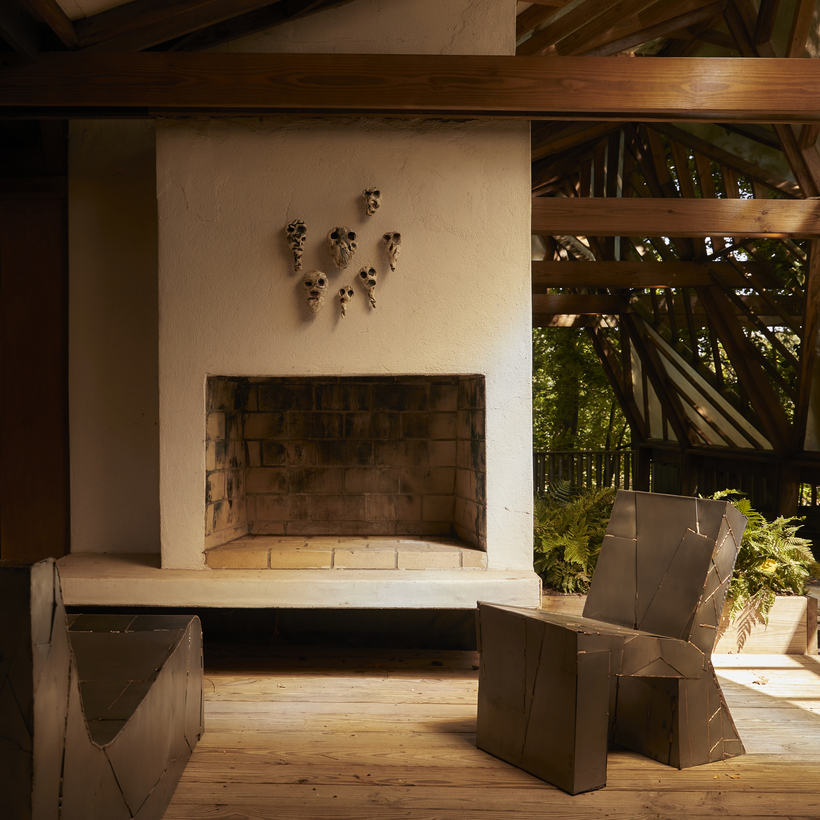New Jersey isn’t the first place you imagine when you think of the word “Zen.” The James Rose Center—a Japanese-inspired house and garden in Ridgewood—is a Zen oasis in the northern part of the state. The home was built in 1953 by Rose, a significant modernist landscape architect. At the time, the space was his primary residence, where he lived with his mother and sister. It was influenced by his time spent stationed in Okinawa during World War II as well as his study of Zen Buddhism, which he would take up in the 60s.
Rose passed away in 1991, and his home was turned into a foundation. You can visit it during the warmer months, sit in the garden, gaze upon the home’s intricately designed rooms, and take it all in.

It’s the perfect environment for the latest iteration of Object & Thing, a design fair helmed by Abby Bangser, which this month is partnering with the Green River Project, the design brainchild of Aaron Aujla and Ben Bloomstein, to exhibit at the historic home, populating it with 1940s-era Charles and Ray Eames plywood sculptures and wood-fired porcelain vases from Frances Palmer, among other pieces. Many of the objects were designed specifically for the show, such as a set of American walnut stools made by Green River that play on the shapes Rose would use in his work.
The ones that were not designed specifically for the show fit elegantly within its ethos, like “Pine Barrens,” a film that is screened in a closet of the house. Made in 1975 by the artist Nancy Holt, the experimental film depicts landscapes of rural New Jersey. It’s situated right next to a cashmere Bode sweater titled “Gardens Make Me Laugh.” (The garment, designed by Aujla’s wife, Emily, is a nod to a book Rose wrote during his lifetime).
All of the pieces are sympatico with Rose’s vision. When I speak to Bangser and Aujla on the phone, they tell me as much. Rose “was a character” and people “call him a maverick,” says Bangser. “So we found works that fit with that … that embody that idea of the handmade.”

Aujla remembers the first time he went to the James Rose Center with Bloomstein. It was a perfect distillation of what he was excited about as a designer. The duo kept going back, taking inspiration from cabinets and doors in the home, borrowing a special mask and using it as part of a piece.
Two years ago, they approached Bangser about collaborating on an iteration of Object & Thing. “We thought it would be such a good representation of the values of Green River Project, and the things that Ben and I love,” says Aujla. “It’s a really great experience to see our work, and the work of our contemporaries, in that kind of context.”
Indeed, walking through the space feels almost poetic. It smells like gorgeous old wood, and everything works in harmony. It’s full of objects you could imagine Rose putting in his home were he alive today. A pair of Green River Project stools placed next to a window are reminiscent of a cozy dinner at home, and, in what was once Rose’s mother’s room, there’s a series of combs made of black walnut, cherry, and rock maples. It feels both playful and deeply elegant.
I was most excited by Clementine Keith-Roach’s Mirror, a huge terra-cotta bowl with a woman’s legs at the base. It sat right next to a window with a bullet hole that variegated the glass. That hole was all Rose—he thought he saw an intruder some decades ago. It’s all in the details.
“At the Rose House: Green River Project LLC and Object & Thing” is on at the James Rose Center through October 2
Sophie Kemp is a New York–based writer. She is a contributor to AIR MAIL’s Arts Intel Report
